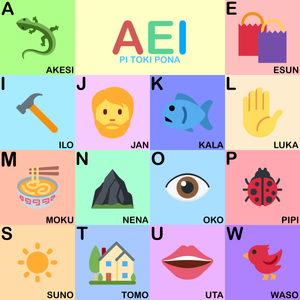sitelen Lasina
sitelen Lasina is a common tokiponized name for the Latin alphabet, particularly as used to write Toki Pona. According to the 2022 Toki Pona census, it is by far the most commonly used writing system for Toki Pona, preferred by about 3 times as many people as the bespoke sitelen pona.[1]
Letters[edit | edit source]

Toki Pona uses 14 letters. Consonants are pronounced as in the International Phonetic Alphabet.[a] For more about pronunciation, see Phonology.
| j | k | l | m | n | p | s | t | w |
| [j] | [k] | [l] | [m] | [n] | [p] | [s] | [t] | [w] |
Vowels can also be pronounced as in the IPA, but according to pu are ideally more centered, with /a/ being centralized and /e o/ being lowered to mid.
| a | e | i | o | u |
| [ä] | [e̞] | [i] | [o̞] | [u] |
Alphabet[edit | edit source]
sitelen Lasina has no official alphabetical order or letter names. In practice, the collation order of the ISO basic Latin alphabet (identical to that of the English alphabet) is often used to alphabetize lists in sitelen Lasina. This may be influenced by the prevalence of "AEI pi toki pona" alphabet charts.
Capitalization[edit | edit source]
Capital letters are not used in any common words,[a] including at the beginning of a sentence. Thus, most text is completely lowercase. Capitalization is only found in names, and as names are proper adjectives that conventionally follow a common headnoun, sentences always start with lowercase letters.
Suli sitelen ni li ike.(Nonstandard capitalization)
suli sitelen ni li pona.
(Standard capitalization)
Autocorrect may add unwanted capitalization that is nonstandard in sitelen Lasina. See Autocorrect § Dealing with automatic capitalization.
Punctuation[edit | edit source]
Punctuation in sitelen Lasina is not expressly defined in the Official Toki Pona books. The most common punctuation marks are the full stop (or period) and the colon as sentence separators, as well as the question mark, exclamation mark, and the comma, which are optional.
The question mark is generally limited to sentences that are grammatically marked as questions. The exclamation mark is more permissive. It is used for commands, exclamations, interjections, and generally in sentences with a and o, but sometimes to mark emphasis in sentences without a spoken a.
The comma is often used to disambiguate sentences by dividing them up,[2] or to make long sentences easier to read. It may be placed before or after the particle la, or not at all; in the Toki Pona Dictionary, jan Sonja calls this a "stylistic choice".[3]
Quotation marks are sometimes used to clarify quoted speech.
The hyphen is generally not used in sitelen Lasina, instead being used as a control character in ASCII transcription of sitelen pona, where it is not supposed to appear verbatim.
See also[edit | edit source]
Notes[edit | edit source]
References[edit | edit source]
- ↑ Results of the 2022 Toki Pona census - Writing systems
- ↑ jan Koko. (14 January 2024). [Message posted in the
#sona-kulupuchannel in the ma pona pi toki pona Discord server]. Discord. Retrieved 3 February 2024. "how do you use commas in sitelen Lasina?".How do you use commas in sitelen Lasina? Option Votes
(multiple choice)In place of period when the ideas are relevant 29 In order to split up lengthy sentences 52 In order to represent pause in speech 58 In order to disambiguate sentences 16 After addressing someone 78 Before or after a 34 Before or after a a a 20 Before or after anu seme 18 Before or after la 74 Before or after taso 37 I don't/try not to use commas 17 - ↑ Lang, Sonja. (18 July 2021). Toki Pona Dictionary. Illustrated by Vacon Sartirani. Tawhid. ISBN 978-0978292362. p. 9.
| Development and usage | jan Sonja · Toki Pona: The Language of Good (2014) · Tokiponidos · Software (Tools · Fonts) · suno pi toki pona · Toki Pona census · Toki Pona Dictionary (2021) · UCSUR · Linku · ISO 639-3 |
|---|---|
| Conventions | Phonology (Phonotactics) · Words (Tokiponization) · Grammar (Word order) · Social conventions · Writing systems (sitelen Lasina · sitelen pona · sitelen sitelen) · luka pona (sign language) · Number systems · Calendar systems · Styles (pu · pu-rism · ku · Nonstandard) |
| Philosophy | Minimalism · Context · Circumlocution · Expression · Lexicalization · Multiple sentences · Comparisons |
| Resources | Frequently asked questions · Courses · Dictionaries · Cheat sheets · Visual aids · Communities · Websites · Media |
| pu | sitelen Lasina (Latin) · sitelen pona (sitelen-pona) · sitelen sitelen |
|---|---|
| Natlang transliterations | sitelen Kililisa (Cyrillic) · sitelen Kana (Japanese) · sitelen Anku (Hangul) · sitelen Kansi (Chinese) · sitelen Alapi (Arabic) · sitelen Iwisi (Hebrew) · sitelen Elina (Greek) |
| Other | Toki Pona Script (dingbats) · sitelen pona pi jan Mimoku · ASCII syllabary · sitelen musi · sitelen ko (cuneiform) · sitelen telo · leko pona (3D) · sitelen mun (Gallifreyan) · nasin pi sitelen jelo (emoji) |